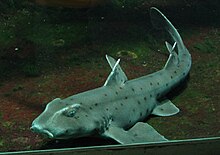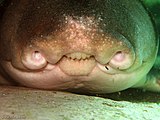Bullhead shark
| Bullhead shark Temporal range:
| |
|---|---|

| |
| Horn shark, Heterodontus francisci | |
| Scientific classification | |
| Domain: | Eukaryota |
| Kingdom: | Animalia |
| Phylum: | Chordata |
| Class: | Chondrichthyes |
| Subclass: | Elasmobranchii |
| Clade: | Neoselachii |
| Subdivision: | Selachimorpha |
| Superorder: | Galeomorphii |
| Order: | Heterodontiformes |
| Family: | Heterodontidae J. E. Gray, 1851 |
| Genus: | Heterodontus Blainville, 1816 |
| Type species | |
| Squalus portusjacksoni F. A. A. Meyer, 1793
| |
| Species | |
|
See text | |
The bullhead sharks are members of the genus Heterodontus, the only members of the family Heterodontidae and only living members of the order Heterodontiformes. All are relatively small, with the largest species reaching just 1.65 metres (5.5 ft) in maximum length. They are bottom feeders in tropical and subtropical waters.
The Heterodontiforms appear in the fossil record in the Early Jurassic.[1] The oldest fossils of the modern genus date to the Late Jurassic. Despite the very ancient origins of this genus and its abundance in the fossil record, phylogenetic evidence indicates that all extant species in the genus arose from a single common ancestor that survived the Cretaceous-Paleogene extinction, with diversification into modern species only starting around the mid-Eocene.[2]
Description
[edit]Bullhead sharks have blunt, proportionally large heads though relatively small mouths, with pronounced ridges above their eyes. They have two dorsal fins, each of which has a rigid fin spine at the front, along with an anal fin.[3] Their body has a tapered profile. The nostrils are proportionally large. They reach around 70–130 centimetres (2.3–4.3 ft) in length.[4] Bullhead sharks have differentiated teeth, with cusped grasping teeth at the front of the mouth, and flattened teeth at the back of the mouth.[2] Their egg cases have a spiral colarette running along their length.[5]
Ecology
[edit]Bullhead sharks live in coastal littoral environments,[2] generally shallower than 100 metres (330 ft).[4] Bullhead sharks use suction feeding.[6] They feed on both hard (such as crustaceans and sea urchins) and soft bodied (such as octopuses) invertebrate prey as well as fish.[7] They use their flattened teeth at the back of the mouth to crush hard-shelled prey and fish.[2] Juvenile prey generally take softer prey than adults.[4]

Species
[edit]Ten living species of bullhead shark have been described:
- Heterodontus francisci (Girard, 1855) (horn shark)
- Heterodontus galeatus (Günther, 1870) (crested bullhead shark)
- Heterodontus japonicus (Maclay & W. J. Macleay, 1884) (Japanese bullhead shark)
- Heterodontus marshallae White, Mollen, O'Neill, Yang & Naylor, 2023 (painted hornshark)
- Heterodontus mexicanus (L. R. Taylor & Castro-Aguirre, 1972) (Mexican hornshark)
- Heterodontus omanensis (Z. H. Baldwin, 2005) (Oman bullhead shark)
- Heterodontus portusjacksoni (F. A. A. Meyer, 1793) (Port Jackson shark)
- Heterodontus quoyi (Fréminville, 1840) (Galapagos bullhead shark)
- Heterodontus ramalheira (J. L. B. Smith, 1949) (whitespotted bullhead shark)
- Heterodontus zebra (J. E. Gray, 1831) (zebra bullhead shark)
-
A Port Jackson shark, Heterodontus portusjacksoni
-
Zebra bullhead shark, Heterodontus zebra
See also
[edit]References
[edit]- ^ Slater, Tiffany S.; Ashbrook, Kate; Kriwet, Jürgen (August 2020). Cavin, Lionel (ed.). "Evolutionary relationships among bullhead sharks (Chondrichthyes, Heterodontiformes)". Papers in Palaeontology. 6 (3): 425–437. doi:10.1002/spp2.1299. hdl:10468/10339. ISSN 2056-2799.
- ^ a b c d Slater, Tiffany S.; Ashbrook, Kate; Kriwet, Jürgen (2020). Cavin, Lionel (ed.). "Evolutionary relationships among bullhead sharks (Chondrichthyes, Heterodontiformes)". Papers in Palaeontology. 6 (3): 425–437. doi:10.1002/spp2.1299. hdl:10468/10339. ISSN 2056-2799.
- ^ White, William T.; Mollen, Frederik H.; O’Neill, Helen L.; Yang, Lei; Naylor, Gavin J. P. (2023-07-12). "Species in Disguise: A New Species of Hornshark from Northern Australia (Heterodontiformes: Heterodontidae)". Diversity. 15 (7): 849. doi:10.3390/d15070849. ISSN 1424-2818.
{{cite journal}}: CS1 maint: unflagged free DOI (link) - ^ a b c Carvalho, Marcelo (2002). "Heterodontiformes (Bullhead or Horn Sharks)". Grzimek's Animal Life Encyclopedia – via Encyclopedia.com.
- ^ Fischer, Jan; Licht, Martin; Kriwet, Jürgen; Schneider, Jörg W.; Buchwitz, Michael; Bartsch, Peter (2014-04-03). "Egg capsule morphology provides new information about the interrelationships of chondrichthyan fishes". Journal of Systematic Palaeontology. 12 (3): 389–399. doi:10.1080/14772019.2012.762061. ISSN 1477-2019.
- ^ Edmonds, Margaret A.; Motta, Philip J.; Hueter, Robert E. (December 2001). "Food capture kinematics of the suction feeding horn shark, Heterodontus francisci". Environmental Biology of Fishes. 62 (4): 415–427. doi:10.1023/A:1012205518704. ISSN 0378-1909.
- ^ Cortés‐Fuentes, Christian; Simental‐Anguiano, María del Rosario; Galván‐Magaña, Felipe; Medina‐López, Marco Antonio (April 2020). "Feeding habits of the horn shark Heterodontus francisci (Girard, 1855) in the northwest of Baja California Sur, Mexico". Journal of Applied Ichthyology. 36 (2): 197–202. doi:10.1111/jai.14004. ISSN 0175-8659.
Further reading
[edit]- Compagno, Leonard (2002) Sharks of the World: Bullhead, mackerel and carpet sharks Volume 2, FAO Species Catalogue, Rome. ISBN 92-5-104543-7.



